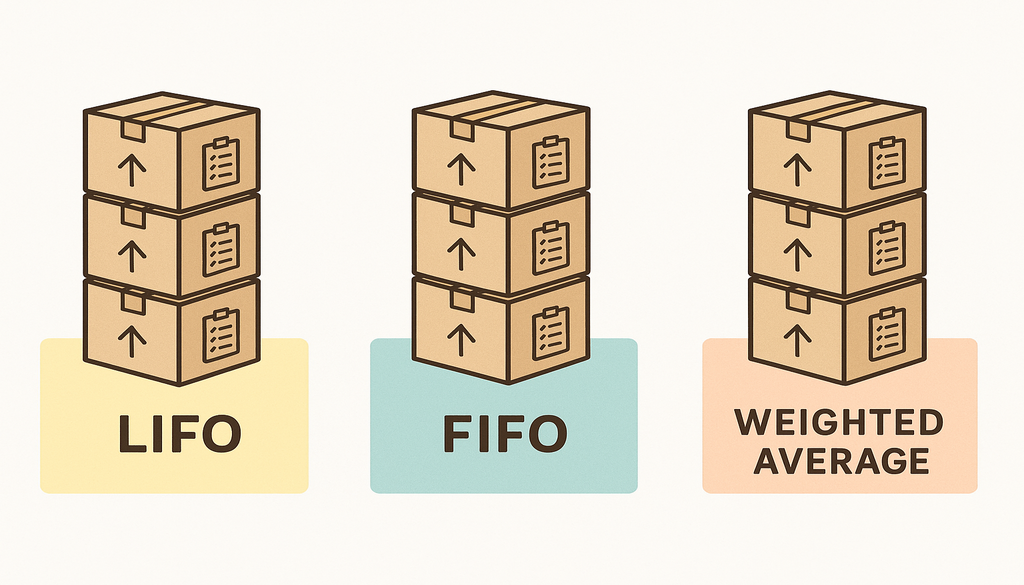What is the LIFO Inventory Method?
The Last-In, First-Out (LIFO) inventory method is an accounting technique that assumes the most recently acquired inventory items are sold first. This approach stands in contrast to other inventory valuation methods such as First-In, First-Out (FIFO) or weighted average cost. Under LIFO, the cost of the newest items purchased or produced is matched against the revenue from current sales, while older inventory costs remain in the inventory account on the balance sheet. For businesses operating in industries with fluctuating prices or inflationary environments, LIFO can offer significant advantages in terms of tax liability reduction and more accurate representation of current costs. Understanding the mechanics and implications of this inventory valuation method is crucial for financial decision-makers, accountants, and supply chain professionals who seek to optimize their company’s financial performance and tax position.
The LIFO method has been a part of accounting practices for decades, though its usage varies significantly across different countries due to varying accounting standards. In the United States, LIFO is permitted under Generally Accepted Accounting Principles (GAAP), making it a common choice for many American businesses. However, International Financial Reporting Standards (IFRS) prohibit the use of LIFO, creating an important consideration for multinational corporations and businesses with international operations. This discrepancy between accounting standards represents just one of many factors that companies must evaluate when determining the most appropriate inventory valuation method for their specific circumstances and operational needs.
How LIFO Works in Practice
When a company implements the LIFO inventory method, it essentially creates layers of inventory costs that reflect the different prices paid for goods over time. Each new purchase forms a new cost layer. When sales occur, the cost of goods sold (COGS) is calculated using the most recent layers first. This practice means that in periods of rising prices, higher costs are matched against current revenue, resulting in lower reported profits and, consequently, lower taxable income. For example, if a warehouse receives 100 units at $10 each in January, and then 100 more units at $12 each in June, a July sale of 120 units would be costed as all 100 units from the June purchase at $12 each, plus 20 units from the January purchase at $10 each, resulting in a COGS of $1,400 ($1,200 + $200).
The practical implementation of LIFO requires careful record-keeping and accounting systems capable of tracking multiple inventory layers. Companies must maintain detailed records of purchase dates and costs to ensure accurate valuation of both cost of goods sold and remaining inventory. This process becomes increasingly complex as businesses deal with diverse product lines, multiple suppliers with varying price points, and frequent inventory turnover. Many enterprise resource planning (ERP) systems and inventory management software solutions now include built-in functionality to handle LIFO calculations, making the method more accessible to businesses of all sizes. Despite the administrative challenges, many companies find that the potential tax benefits and improved cost-flow assumptions justify the additional complexity of implementing and maintaining a LIFO inventory system.
Advantages of Using LIFO
The primary advantage of the LIFO method in inflationary economic periods is its potential for significant tax benefits. Since LIFO assigns the most recent (and typically higher) costs to cost of goods sold, it results in lower reported profits compared to other methods like FIFO. This reduction in taxable income can translate to substantial tax savings, particularly for businesses with large inventories or those operating in sectors with rapidly increasing costs. For instance, a manufacturing company facing rising raw material prices might save hundreds of thousands of dollars annually in tax payments by implementing LIFO. These tax advantages can free up capital for business investments, debt reduction, or other strategic initiatives that enhance long-term competitiveness and financial stability.
Another significant benefit of LIFO is its ability to provide a more accurate matching of current costs against current revenues on the income statement. This matching principle is a fundamental concept in accounting, and LIFO excels at implementing it during inflationary periods. When current sales are matched with current costs, the resulting gross profit figure more realistically reflects the company’s true operating performance. This improved cost-flow assumption helps management make better-informed decisions based on up-to-date cost information rather than potentially outdated historical costs. Additionally, this more accurate cost matching can help businesses set appropriate pricing strategies that reflect their actual replacement costs, ensuring that profit margins remain stable despite rising input costs.
For businesses with slow-moving inventory or products that maintain stable physical characteristics over time, LIFO can be particularly advantageous. Industries such as manufacturing, wholesale distribution, automotive parts, and construction materials often benefit from LIFO because their inventory items are relatively interchangeable and do not deteriorate or become obsolete quickly. In these scenarios, older inventory items can remain in stock indefinitely without concerns about physical deterioration, making the theoretical “last-in, first-out” flow more acceptable even if it doesn’t match the actual physical flow of goods. This aspect of LIFO allows these businesses to realize the tax and financial reporting benefits without experiencing practical disadvantages related to inventory management or product quality.
Disadvantages and Limitations
Despite its advantages, the LIFO method comes with several significant drawbacks that businesses must carefully consider. One of the most notable limitations is that LIFO can lead to an undervaluation of inventory on the balance sheet, particularly during extended periods of inflation. As newer, higher-cost items are sold first, the remaining inventory value reflects older, potentially much lower historical costs. This situation can result in financial statements that don’t accurately represent the current replacement value of inventory assets, potentially distorting key financial ratios and metrics that investors, lenders, and other stakeholders rely on for decision-making. For example, a manufacturing company that has used LIFO for decades might report inventory at values that are substantially below current market prices, understating the true economic value of its assets and potentially affecting its perceived financial health.
International compatibility presents another major challenge for companies using LIFO. As mentioned earlier, the International Financial Reporting Standards (IFRS) prohibit the use of LIFO, creating complications for multinational corporations or businesses considering global expansion. Companies that report under both GAAP and IFRS must maintain parallel inventory accounting systems or make conversion adjustments, adding administrative complexity and cost. Furthermore, businesses contemplating international mergers, acquisitions, or public offerings on foreign exchanges may need to reconsider their inventory valuation method, as switching away from LIFO can trigger significant tax liabilities from the recapture of the “LIFO reserve” – the difference between inventory valuation under LIFO versus FIFO.
Implementation and maintenance of LIFO can also pose operational challenges. The method requires sophisticated inventory tracking systems and detailed historical cost records to properly calculate inventory layers and cost of goods sold. For businesses with diverse product lines, frequent price changes, or complex supply chains, these record-keeping requirements can be burdensome. Additionally, companies using LIFO may face complications when inventory levels decrease significantly – a phenomenon known as a “LIFO liquidation.” When older, lower-cost inventory layers are accessed due to inventory reduction, companies experience artificially inflated profits and higher tax liabilities, potentially negating the cumulative tax benefits previously gained through LIFO. This risk requires careful inventory management and planning to avoid unexpected tax consequences during business downturns or strategic inventory reductions.
LIFO vs. Other Inventory Methods
When comparing LIFO to the FIFO (First-In, First-Out) method, several key differences emerge that significantly impact financial reporting and business operations. FIFO assumes that the oldest inventory items are sold first, resulting in inventory valuations that more closely align with current replacement costs on the balance sheet. During inflationary periods, FIFO typically reports higher profits than LIFO because older, less expensive items are expensed first through cost of goods sold. While this leads to higher taxable income, it also results in stronger financial metrics, including higher gross margins, net income, and equity values – factors that may appeal to investors and creditors. FIFO also tends to better represent the actual physical flow of goods in most businesses, as companies typically sell older stock before newer arrivals to minimize spoilage and obsolescence. The choice between these methods involves balancing tax considerations against financial statement presentation and operational realities.
The Weighted Average Cost method offers a middle ground between LIFO and FIFO by calculating inventory cost based on the average cost of all items available for sale during the period. This approach smooths out price fluctuations and provides more consistent gross profit margins compared to the potentially volatile results under LIFO or FIFO in rapidly changing price environments. The Weighted Average method is particularly suitable for businesses where inventory items are indistinguishable from one another, such as commodity products or raw materials. It also simplifies inventory tracking since individual cost layers don’t need to be maintained, making it less administratively burdensome than LIFO. For businesses seeking balance between tax efficiency, financial statement presentation, and operational simplicity, weighted average costing represents a compelling alternative that avoids some of the extreme outcomes possible under either LIFO or FIFO.
The Specific Identification method, unlike the other approaches, tracks the actual cost of each individual inventory item from purchase through sale. This highly detailed method is primarily used for high-value items where tracking individual units is feasible and meaningful, such as automobiles, jewelry, or custom machinery. Specific Identification provides the most accurate matching of costs to revenues but requires sophisticated tracking systems and is impractical for businesses with high-volume, homogeneous products. Understanding these alternative methods helps businesses make informed decisions about which inventory valuation approach best suits their industry, tax situation, financial reporting goals, and operational capabilities. Many companies find that different inventory methods may be appropriate for different product lines or business units within their organization, adding another layer of complexity to this important accounting decision.
Implementing LIFO in Your Business
Transitioning to the LIFO inventory method requires careful planning and preparation. The first step involves obtaining IRS approval by filing Form 970, “Application to Use LIFO Inventory Method,” with your tax return for the year in which you implement LIFO. This form must be submitted within the tax filing deadline, including extensions. Before making the switch, businesses should conduct a thorough analysis of their inventory patterns, price trends, and tax situations to ensure LIFO will provide the anticipated benefits. This analysis should include projections of how LIFO might affect financial statements and tax liabilities over several years under different inflation scenarios. Additionally, companies should review their inventory management practices and accounting systems to confirm they can support the more complex record-keeping requirements of LIFO. Engaging tax professionals and accounting experts with specific experience in LIFO implementations is highly recommended to navigate the technical requirements and avoid costly mistakes in the transition process.
Successful implementation of LIFO depends heavily on establishing robust inventory tracking and record-keeping systems. These systems must be capable of maintaining historical cost data for each inventory layer and accurately calculating cost of goods sold based on the LIFO assumption. Many businesses find they need to upgrade their inventory management software or modify existing ERP systems to accommodate LIFO requirements. Staff training is another critical component of the implementation process, as accounting personnel need to understand the mechanics of LIFO calculations and their implications for financial reporting. Companies should also develop clear procedures for handling inventory counts, valuations, and reconciliations under the new method. Thorough documentation of these procedures is essential for maintaining consistency in application and for supporting the method during tax audits or financial statement reviews.
Once LIFO is implemented, businesses must vigilantly monitor and manage their inventory levels to avoid unintended consequences. One particular concern is the “LIFO liquidation” scenario mentioned earlier, where decreasing inventory levels can lead to accessing older, lower-cost layers and triggering unexpected taxable income. To mitigate this risk, companies should develop inventory management strategies that maintain sufficient stock levels, particularly at year-end when inventory valuations impact annual financial statements and tax returns. Regular review of LIFO calculations and results is also important to ensure the method continues to provide the expected benefits as business conditions and inflation rates change. Many companies find it valuable to periodically reassess their inventory valuation method choice, particularly after significant changes in tax regulations, business operations, or corporate strategy. With proper implementation and ongoing management, LIFO can be a valuable tool for optimizing a company’s financial position and tax efficiency in the appropriate circumstances.
Conclusion
The LIFO inventory method represents a strategic accounting choice that can significantly impact a company’s financial reporting, tax liability, and operational decisions. For businesses operating in inflationary environments or industries with fluctuating costs, LIFO offers compelling tax advantages by matching current costs against current revenues, potentially freeing up capital that would otherwise go toward tax payments. However, these benefits must be weighed against the method’s limitations, including balance sheet undervaluation, international reporting incompatibility, and increased administrative complexity. The decision to implement LIFO should never be made lightly, but rather should result from thorough analysis of company-specific factors including inventory characteristics, price trends, business goals, and technological capabilities.
As with many accounting decisions, there is no universal “best” inventory valuation method. Each approach—whether LIFO, FIFO, weighted average, or specific identification—offers distinct advantages and drawbacks that align differently with various business models and objectives. Financial decision-makers must carefully evaluate these trade-offs in the context of their specific industry, inventory patterns, and strategic priorities. For companies that do determine LIFO is appropriate, careful implementation planning and ongoing management are essential to maximize benefits while minimizing potential complications. By approaching the LIFO decision with a comprehensive understanding of its implications and requirements, businesses can make informed choices that optimize their financial performance and support their long-term strategic objectives in an ever-changing economic landscape.
Frequently Asked Questions (FAQ)
Is LIFO allowed under all accounting standards?
No, LIFO is not universally accepted across all accounting standards. While it is permitted under U.S. Generally Accepted Accounting Principles (GAAP), the International Financial Reporting Standards (IFRS) explicitly prohibit the use of LIFO for inventory valuation. This discrepancy creates challenges for multinational corporations that report financial results in multiple jurisdictions or companies considering international expansion. Businesses that currently use LIFO but plan to adopt IFRS in the future should be aware that they will need to transition to another inventory method, potentially triggering significant tax consequences from the LIFO reserve recapture.
How does inflation affect LIFO inventory valuation?
Inflation significantly impacts LIFO inventory valuation by creating larger differentials between older and newer inventory costs. During inflationary periods, newer inventory purchases cost more than older ones, resulting in higher cost of goods sold under LIFO. This higher COGS reduces reported profits and taxable income, generating tax savings that represent the primary advantage of LIFO. However, inflation also widens the gap between the reported inventory value on the balance sheet (based on older, lower costs) and the current replacement cost of that inventory. The longer a company uses LIFO during inflation, the more substantial this balance sheet undervaluation becomes, potentially distorting financial ratios and complicating business valuations.
What industries benefit most from using LIFO?
Industries with significant inventories subject to price inflation typically benefit most from LIFO. These include manufacturing, distribution, retail, automotive, construction materials, metals, chemicals, and energy companies. Businesses with commoditized products or raw materials that experience regular price increases are particularly well-positioned to realize tax advantages from LIFO. Additionally, industries with inventory that doesn’t deteriorate or become obsolete quickly find LIFO practically feasible, as the theoretical “last-in, first-out” flow doesn’t create operational issues related to aging stock. Companies with high inventory turnover and consistent or growing inventory levels can also benefit, as they avoid the negative consequences of LIFO liquidations that occur when inventory levels decrease substantially.
What is a LIFO liquidation and why is it problematic?
A LIFO liquidation occurs when a company’s inventory levels decrease to the point where older, historical cost layers must be accessed to fulfill sales. This situation typically happens during business downturns, supply chain disruptions, or strategic inventory reductions. LIFO liquidations are problematic because they can trigger significant unexpected tax liabilities. Since these older inventory layers were acquired at lower historical costs, expensing them results in artificially lower COGS and correspondingly higher taxable income. This effectively reverses the cumulative tax benefits previously realized through LIFO, often at the worst possible time – when a business is already experiencing operational challenges that led to the inventory reduction. Careful inventory management and planning are essential to avoid unintended LIFO liquidations, particularly around year-end.
Can a company switch from another inventory method to LIFO?
Yes, companies can switch from another inventory method to LIFO, but the transition requires IRS approval and careful planning. To make the change, businesses must file Form 970 with their tax return for the year of implementation. The switch typically creates a “LIFO reserve,” representing the difference between inventory valuation under the previous method and LIFO. While this transition doesn’t immediately trigger tax consequences, businesses should be aware that returning to their original method in the future would require recognizing the accumulated LIFO reserve as taxable income. Before switching to LIFO, companies should conduct thorough analysis with qualified tax professionals to ensure the long-term benefits outweigh the additional compliance requirements and potential future tax implications of the change.









